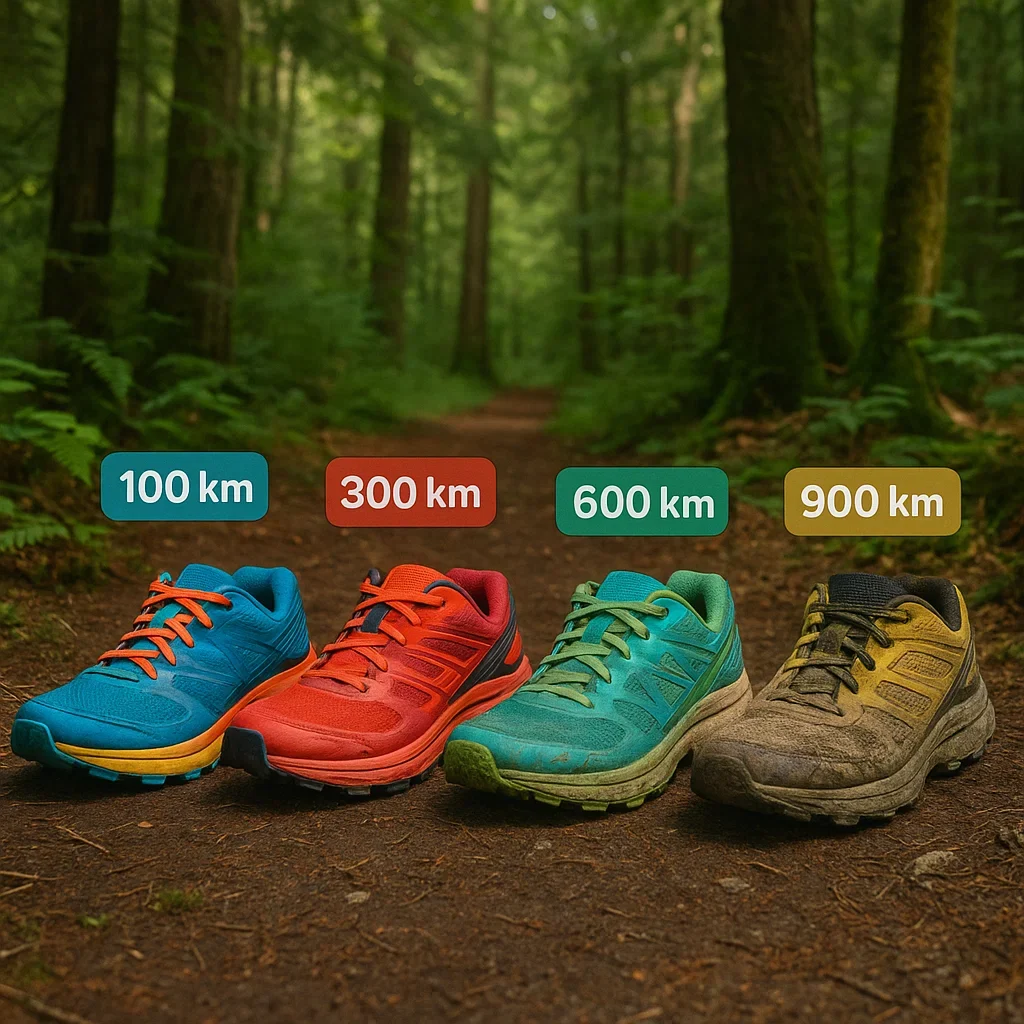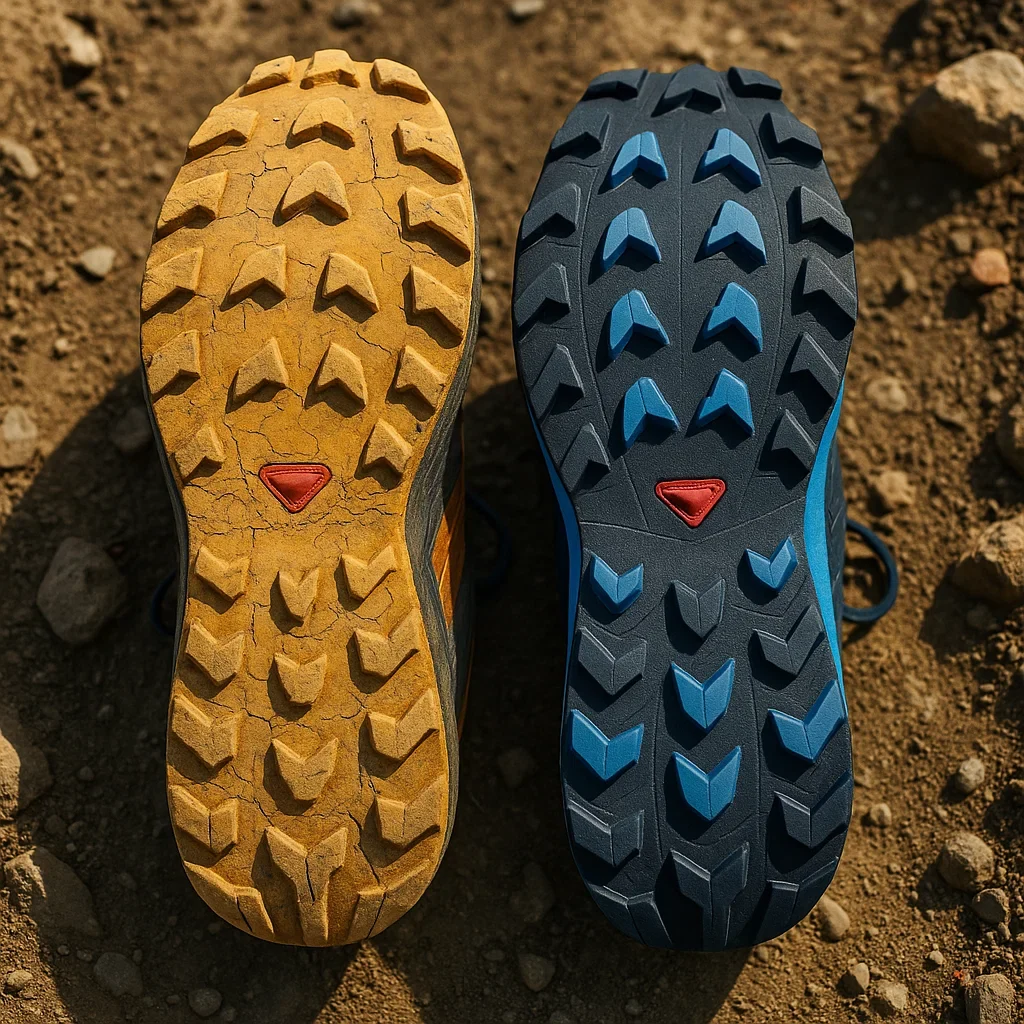How many kilometers can your trail running shoes truly last on rough sub-ultra distances? Shoe durability is the secret weapon of every serious trail runner—not just for saving money, but for safety, performance, and comfort. This in-depth guide explains what affects shoe lifespan, how to get the most from every pair, and when to finally retire your trusted trail companions.
See the main guide: Best Trail Running Shoes for Sub-Ultra Distances
⏳ Why Shoe Durability Matters for Sub-Ultra Runners
On the trail, your shoes are your only line of defense against sharp rocks, sticky mud, and thousands of impact cycles. If they wear out too soon, you risk blisters, fatigue, or even injury—especially in demanding 20–49 km races. Plus, durable shoes save money and help the environment by reducing waste.
- Performance: Worn-out shoes lose grip, cushioning, and structure—leading to slower times and higher injury risk.
- Value: Shoes that last 700 km cost you half as much per kilometer as shoes that fail at 300 km!
- Confidence: Trusting your shoes on tricky descents means you can race harder and enjoy the adventure more.
🧬 What Affects Trail Shoe Durability?
- Materials: Premium rubber outsoles (e.g., Vibram®), reinforced mesh uppers, and resilient midsoles (EVA, TPU) last longer than budget alternatives.
- Outsole Type: Deep, sticky lugs wear faster on asphalt. Shallow, hard rubber lasts longer but can slip on mud.
- Terrain: Rocky, technical trails and frequent asphalt connectors speed up wear. Soft, loamy forest preserves shoes best.
- Runner Weight & Gait: Heavier runners and those with aggressive, forceful strides compress foam and wear soles quicker.
- Weather & Care: Heat, humidity, improper drying, and poor cleaning can break down shoe glue and materials fast.
Pro tip: Rotating between two pairs (training/racing) can extend the life of both.
📊 Mileage Expectations for Trail Running Shoes
Most quality trail shoes are built to last 400–800 km, but real-world mileage depends on use, shoe type, and your personal habits.
| Shoe Type | Expected Mileage (km) | Best Use | Wear Risks |
|---|---|---|---|
| Lightweight Race | 250–450 | Fast sub-ultra, dry, race-only | Outsole/lug wear, upper tears |
| Cushioned Trainer | 400–700 | Daily, long runs, rocky | Midsole compression, heel breakdown |
| Waterproof/GORE-TEX | 350–600 | Wet, cold, winter, mud | Membrane leaks, seam splits |
| Minimalist | 350–700 | Technical, soft, agile | Outsole smooths, upper holes |
| “Tank”/Ultra-Durable | 600–900 | Rugged, mountain, multi-day | Usually outsole smooths first |
- Lightweight shoes are faster, but tend to wear out 30–40% sooner than daily trainers.
- Waterproof shoes’ lifespan is limited by membrane integrity—once they leak, they’re just regular shoes.
- Zero-drop/minimal shoes may last longer if used only on soft ground, but technical trails wear soles faster.
🛑 Signs Your Trail Shoes Need Replacing
- Grip faded—outsole lugs are flat, smooth, or peeling at the edges
- Midsole “dead”—foam is hard, less springy, or visibly creased
- Upper breakdown—mesh tears, seam splits, or ankle collar collapsed
- Shoe “leans” to one side, causing foot or knee pain
- New aches, blisters, or hot spots where there were none before
- Waterproof membrane leaks or holds persistent odor
Pro tip: Always check shoes in bright light—damage is easier to spot outside!
🥇 Best Durable Trail Shoes for Sub-Ultra Distances (2025)
| Model | Durability Score (1–10) | Outsole | Best Terrain | Notable Feature |
|---|---|---|---|---|
| La Sportiva Ultra Raptor II | 10 | FriXion® XF | Rock, alpine, technical | Tank-like build, Vibram rubber |
| Salomon XA Pro 3D V9 | 9 | Contragrip® | Technical, mixed | Reinforced toe, all-weather |
| Brooks Cascadia 17 | 8 | TrailTack® | All-rounder | Stable, versatile, proven |
| Hoka Torrent 3 | 8 | Rubber | Mixed, speed | Durable for weight, fast |
| Inov-8 Roclite G 275 | 9 | Graphene | Mud, technical | Superb grip, long-lasting lugs |
| Merrell Agility Peak 5 | 8 | Vibram® MegaGrip | Long distance, mixed | Great midsole resilience |
| Altra Lone Peak 8 | 7 | MaxTrac™ | Technical, wide fit | Wide toe box, zero-drop |
| Adidas Terrex Agravic Ultra | 8 | Continental™ | Mixed, rocky | Sturdy upper, long lugs |
- La Sportiva Ultra Raptor II: Legendary for mountain ultras, built like a tank, and outlasts most shoes by 200+ km.
- Inov-8 Roclite G 275: Graphene outsole is scientifically proven to resist wear longer than standard rubbers—ideal for Turkish terrain.
- Brooks Cascadia 17: Consistently scores high for durability and comfort across a range of conditions.
🛠️ How to Extend the Life of Your Trail Shoes
- Rinse mud, sand, and grit off after every run—especially from the outsole and mesh.
- Air dry at room temperature. Avoid direct sunlight, radiators, or hair dryers!
- Remove insoles and stuff shoes with newspaper to speed up drying.
- Patch small holes in uppers with strong adhesive (Shoe Goo, Tenacious Tape).
- Rotate between at least two pairs (training/racing) for maximum lifespan.
- Store in a dry, cool area—avoid leaving in hot cars or humid basements.
Pro tip: Most damage occurs in the first hour after a wet/muddy run—clean and dry ASAP!
🚫 Common Mistakes That Kill Shoe Lifespan
- Machine washing—ruins glue, midsole foam, and membranes
- Drying with direct heat—shrinks and warps shoe structure
- Running on asphalt with deep-lug trail shoes—wears lugs smooth
- Using the same pair every day—no recovery for midsole foam
- Ignoring early signs of wear—small tears become big failures fast
- Storing shoes dirty—dirt and sweat rot fabric and adhesives
🗣️ Real-World Durability: User Reports & Case Studies
“My Ultra Raptors survived two years and nearly 1100 km of Black Sea mountain running—only the lugs finally gave out.”
– Mete, Rize
“Brooks Cascadia lasted over 600 km with weekly cleaning. I finally switched after the toe bumper detached, but grip was still decent.”
– Hande, İzmir
“Cheaper shoes wore out in less than 300 km—next time, I’ll invest in proven models.”
– Bora, Ankara
❓ Frequently Asked Questions
👟 How many kilometers should trail running shoes last?
🦶 How can I tell if my shoes are “dead”?
🧼 Is it safe to machine wash trail shoes?
🌧️ Can I repair waterproof membranes?
🛠️ Are there any professional repair services for trail shoes?
🔄 Should I rotate trail shoes?
💸 Are expensive trail shoes more durable?
📝 Is there a best way to track shoe mileage?
📚 Further Reading
Final Thoughts
Shoe durability isn’t just about saving money—it’s about performance, safety, and confidence on every step. Track your mileage, take care of your shoes, and always listen to your feet. With the right maintenance, you’ll enjoy every run—kilometer after kilometer!


About the Author
Lost Pace is an ultramarathon runner, shoe-tester and the founder of umit.net. Based year-round in Türkiye’s rugged Kaçkar Mountains, he has logged 10,000 + km of technical trail running and completed multiple 50 K–100 K ultras.
Blending mountain grit with data, Lost analyses power (CP 300 W), HRV and nutrition to craft evidence-backed training plans. He has co-written 260 + long-form guides on footwear science, recovery and endurance nutrition, and is a regular beta-tester of AI-driven coaching tools.
When he isn’t chasing PRs or testing midsoles, you’ll find him sharing peer-reviewed research in plain English to help runners train smarter, stay healthier and finish stronger.
Ultrarunner · Data geek · Vegan athlete

